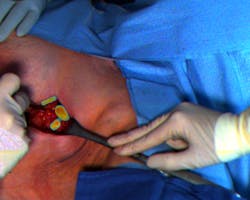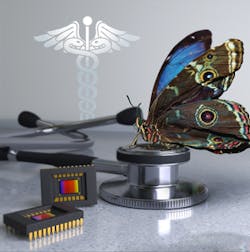Butterfly eyes inspire novel camera design for image-guided cancer surgery
A team of researchers at the University of Illinois at Urbana-Champaign (Champaign, IL) has developed a camera that provides surgeons with traditional color and near-infrared (near-IR) images that make fluorescently labeled cancer cells visible, even under bright surgical lighting. The camera, inspired by the intricate visual system of a butterfly, is designed to help surgeons remove all the cancer cells without damaging healthy tissue, making it less likely that the cancer will spread and reducing the need for multiple surgeries.
Related: NIR image-guided surgery: Progress and needs for clinical application
"Instead of putting together commercially available optics and sensors to build a camera for image-guided surgery, we looked to nature's visual systems for inspiration," explains research team leader Viktor Gruev. "The morpho butterfly, whose eyes contain nanostructures that sense multispectral information, can acquire both near-infrared and color information simultaneously."
In a paper describing the work, the researchers demonstrated that their camera can detect tumors in animals, and is useful for assessing the stage of breast cancer in humans. The camera offers very sensitive fluorescence detection even under standard operating room lighting, weighs less than an AA battery, and can be manufactured for around $20.
"During surgery, it is imperative that all the cancerous tissue is removed, and we've created an imaging platform that could help surgeons do this in any hospital around the world because it is small, compact and inexpensive," Gruev says. "Although we've addressed the instrumentation side, fluorescent markers targeted for cancer and approved for use in people are needed for our technology to find widespread application. Several of these are in clinical trials now, so we should see progress in this area soon."
Many existing U.S. FDA-approved near-IR cameras lack the sensitivity to detect fluorescence markers under surgical settings, so the room lights must be dimmed to view the fluorescence. Another problem with current IR imagers is that the fluorescence image is not always precisely aligned, or coregistered, with the tissue it arises from. This happens because FDA-approved instruments use multiple optical elements, such as beamsplitters and relay lenses, to separate the visible and IR wavelengths so that each can be sent to separate detectors. Slight temperature changes in the room can affect the optics in these instruments, causing image misalignments that could cause a surgeon to miss cancerous tissue while unnecessarily removing healthy issue.
The new camera uses a setup similar to the butterfly eye by interlacing various nanoscale structures with an array of photodetectors, enabling collection of color and near-IR fluorescence information on one imaging device. Integrating the detector and imaging optics into a single monolithic sensor keeps the device small, inexpensive, and insensitive to temperature changes.
The design uniquely solves the sensitivity problem by allowing each pixel to take in the number of photons needed to build up an image. It doesn’t take long to create the visual-wavelength image for viewing the anatomy since the visible illumination in the lab is high. On the other hand, because fluorescence is typically dim, it takes longer to collect a sufficient number of photons to build up a sufficiently bright image. By changing the exposure time to allow each pixel to detect the photons it needs, a bright fluorescence image can be created without overexposing the color image of the tissue.
The researchers tested their new instrument on a mouse model that develops spontaneous breast cancer. This means that the exact location where the cancer will grow is unknown, as is the number of cancer cells. Using fluorescent labels that bind to cancer cells, the researchers showed that their bioinspired imager enabled tumor detection with an accuracy and sensitivity surpassing IR cameras FDA-approved for image-guided surgery.
The researchers also tested the ability of their IR camera to identify lymph nodes in 11 patients with breast cancer at Washington University School of Medicine in St. Louis (Missouri). Because the lymph nodes are one of the primary places where breast cancer spreads, surgeons check them to determine the cancer stage. The patients were injected with FDA-approved indocyanine green fluorescent dye that accumulates passively in the lymph nodes and then fluorescence images from the bioinspired imager were displayed either on a screen or projected onto goggles worn by the surgeons.
"We showed that under bright surgical lights, our instrument was 1000 times more sensitive to fluorescence than the imagers currently approved for infrared image-guided surgery," Gruev says. "Because the bioinspired imager can reveal fluorescence that is deep in the tissue, it sped up the process of lymph node identification and helped surgeons find lymph nodes that couldn’t be seen by eyesight alone."
According to the researchers, the bioinspired imager would be useful for removing various types of cancers, including melanomas, prostate cancer, and head and neck cancers. Because of its small size, it could also be integrated into an endoscope to look for cancer during a colonoscopy, for example.
The researchers are now forming a startup company to commercialize their bioinspired imager and are also working with the FDA to design a clinical trial in which the surgeons can compare clinical decisions made with the new imager with those that would be made with FDA-approved imagers.
Full details of the work appear in the journal Optica.

